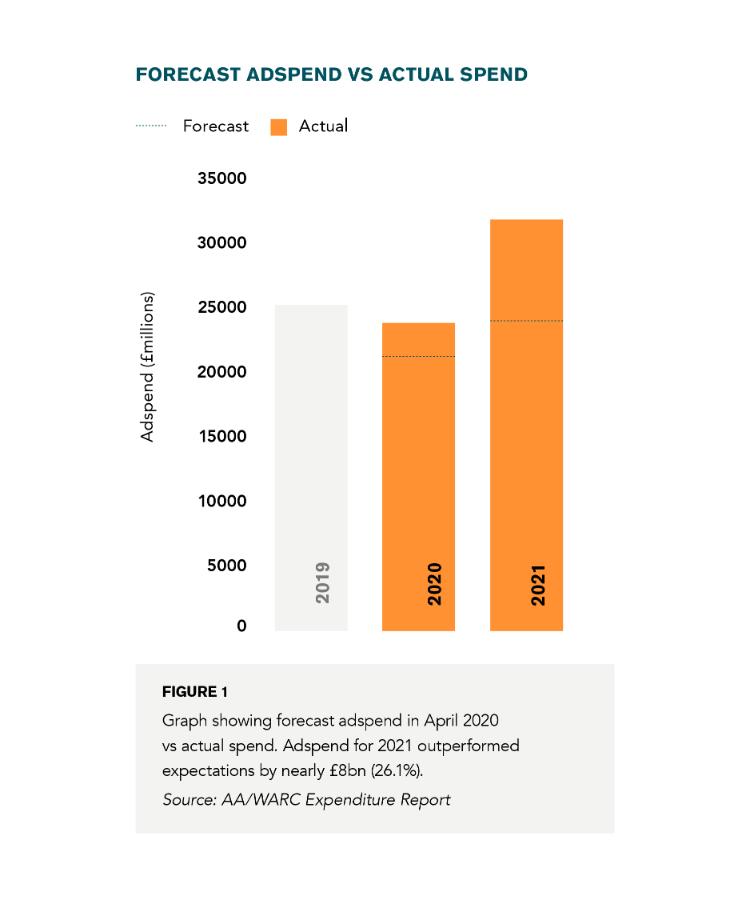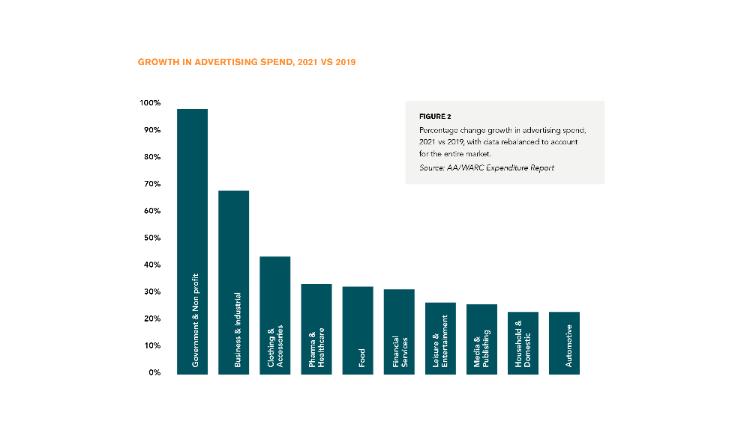New report highlights UK Government role as the UK’s largest advertiser during Covid-19 pandemic
In early 2020, AA/WARC adspend figures predicted the UK advertising market in 2021 would be worth £24bn. Two years on, the 2021 market is worth £8bn more than expected, at a value of £32bn. Stephen Woodford, Chief Executive of the Advertising Association assesses the impact of Covid-19 on the industry.
This is the moment to try to understand what happened and what has driven this extraordinary growth.
A unique report released today by the Advertising Association, based on the final year AA/WARC Expenditure Figures, analyses adspend trends during the first two years of the Covid-19 pandemic. It asks why did spend increase, has the shape of the ad market changed and are there long-lasting implications to these changes? What can we learn from this unprecedented period?

Figure 1: Graph showing forecast adspend in April 2020 vs actual spend. Adspend for 2021 outperformed expectations by £8bn (26.1%). Source: AA/WARC Expenditure Report.
At the time of writing, the UK is once again fully open for business. The three national lockdowns across 2020, 2021 and 2022 have been countered by the rapid delivery of successful vaccination and booster programmes. This has led to fast economic recovery, albeit now one hampered by the war in Europe which is exacerbating already high inflationary pressures.
UK advertising never closed for business during the lockdowns – it found new ways of helping advertisers reach their customers. Online advertising grew in its importance to help businesses connect with customers during lockdowns, as did every media sector which wasn’t closed or restricted by lockdowns.
It is worth reflecting here on the words of AA President, Keith Weed, at the time of the first lockdown – we have seen 15 years of acceleration in 15 days as the UK consumer is forced to shop online like never before. This is in a nation which already has the world’s most avid online shoppers.
The enforced change meant established advertisers shifted money online. It also fast-tracked a huge swathe of online businesses and services which have brought new advertising budgets to the UK advertising market.
This has had a global effect: the UK has held its position as the largest advertising market in Europe and is now the third largest in the world, behind the USA and China.
The pandemic presented our industry with opportunities to innovate, and our industry did exactly that, with the result a significant increase in total adspend – an increase to a larger size than had the pandemic not happened.
In 2021, nearly three-quarters (73.5%) of all UK adspend was spent online, a jump of 11.7 percentage points from our pre-pandemic 2019. The UK is the only international market aside from China with an online share of this proportion. As every media type from magazines to radio increased their online adspend share, it is predicted this share will cross the three quarters point (75.3%) next year.
The latest AA/WARC data shows search, inclusive of e-commerce, proved to be the strongest performer in 2021, at £11.7bn, beating April 2020's projection by an additional £3.7bn. For our workforce, this means a soaring need for digital skills as agencies seek the much-needed talent to deliver these campaigns. But where has this advertising come from?

Figure 2: Percentage change growth in advertising spend, 2021 vs 2019, with data rebalanced to account for the entire market. Source: AA/WARC Expenditure Report
When comparing the growth in advertising spend for 2021 versus 2019, even though we were experiencing unusual times because of the pandemic, certain industries responded with dramatic effect. Within weeks, the UK Government took pole position as the largest advertiser (97% growth versus 2019). Cover wraps in our print media informed the nation with ‘Stay Home’ public health messages; direct mail brought testing kits and essential deliveries to households up and down the country; and billboards showed the everyday heroes in our NHS.
There were notable shifts in adspend by sector during the pandemic with the UK Government quickly becoming the UK’s largest advertiser to drive mass behaviour change.
Business and industrial advertising also saw a large growth (67% vs 2019), as companies promoted new ways of working through lockdowns and then hybrid practices. This is followed by clothing and accessories (43%) as retailers looked to advertising to create engaging online shopping experiences in the absence of in-store customers. Pharma and Healthcare (defined as multivitamins and other over-the-counter treatments) and Food also saw a large growth (32% and 31% respectively), reflecting the increased focus on maintaining good health and eating a greater variety of foods at home.
TV surpassed expectations by almost £1bn in 2021, while online video overperformed by approximately £2bn and social media by £2.3bn. Further stimulation for the market is expected with ITV X, the UK’s first integrated advertising and subscription funded platform, joining the B-VOD players this year. Most recently, the news Netflix may introduce an advertising-based subscription could bring further change in this sector.
The lockdowns saw harsh declines in adspend across the sectors that earn their keep through ‘IRL’ or in-real-life interactions, but they have had some of the strongest bounce backs. Following months of shutdown, cinema and OOH saw double digit growth in 2021. However, there remain challenges for parts of the market that were true before the pandemic.
The UK's ad market in 2021 was £6.6bn larger than before the pandemic; 2020's total losses were recouped entirely in the first half of 2021. Factors such as inflationary pressures on the cost of advertising and the rising cost of living go some way to explaining the swell of the market but these figures show how our industry has adapted to the wider societal shift brought about by the pandemic. We do more of everything online and advertising spend has followed to support businesses seeking to connect with customers online.
Inevitably, there is an increased demand for digital skills and talent, and we are not alone as an industry in this need. Our new President, Tesco’s Chief Customer Officer, Alessandra Bellini, has announced a new talent taskforce to tackle how our industry can access all the talent we will need in the coming years.
The pandemic also saw the launch of two industry initiatives from the AA in partnership with ISBA and the IPA: All In, our inclusion plan, and Ad Net Zero, our climate action plan. As we continue to build back better from the pandemic, UK advertising will firstly be shaped by everyone involved in making and distributing the ads – contingent on building a fully inclusive workforce – and secondly our industry’s ability to help build a sustainable future.
The pandemic has had a significant impact on the size and shape of the UK’s advertising market, and it will continue to do so. Further growth is forecast although inflationary pressures on the cost of advertising, and more generally, due to the ongoing geo-political uncertainties, mean we should be cautious.
What’s important now is to make good on the commitments we have made to build a more inclusive and sustainable industry and address the challenges ahead in securing the talent we need to help businesses, large and small, connect with their customers.
If you’d like to talk more about these figures, we welcome you to come and see us at our new offices in Berners Street in London’s Fitzrovia.
To learn more about the AA/WARC Expenditure Report and to read the latest figures, visit our adspend hub at: https://adassoc.org.uk/advertising-spend/
